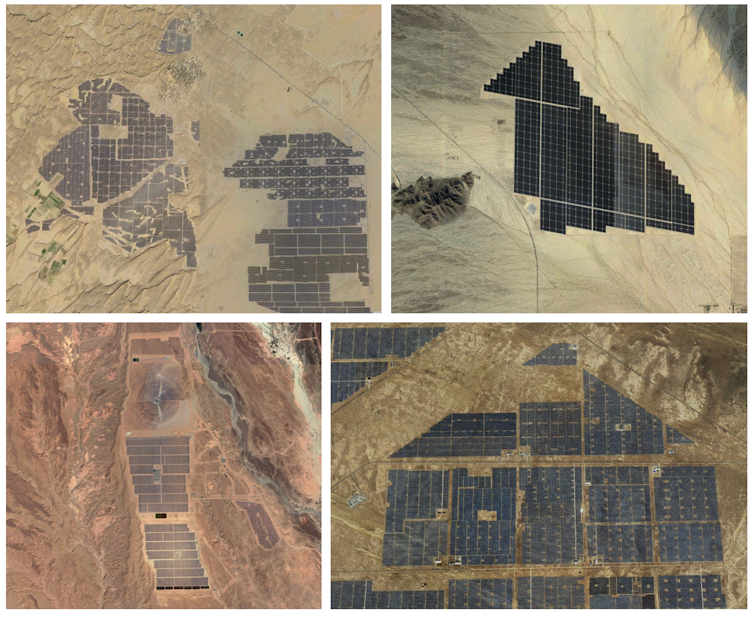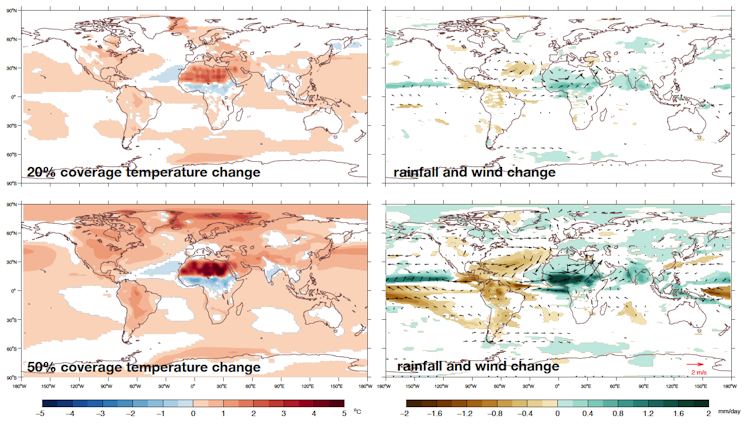
SOLAR PANELS IN THE SAHARA COULD DAMAGE GLOBAL CLIMATE

The world’s most forbidding deserts could possibly be the most effective locations on Earth for harvesting solar energy – probably the most considerable and clear supply of power we now have.
Deserts are spacious, comparatively flat, wealthy in silicon – the uncooked materials for the semiconductors from which photo voltaic cells are made — and by no means wanting daylight. The truth is, the ten largest solar plants world wide are all situated in deserts or dry areas.
Researchers imagine it may be attainable to remodel the world’s largest desert, the Sahara, into an enormous photo voltaic farm, able to assembly four times the world’s present power demand. Blueprints have been drawn up for initiatives in Tunisia and Morocco that might provide electrical energy for hundreds of thousands of households in Europe.
Whereas the black surfaces of photo voltaic panels soak up many of the daylight that reaches them, solely a fraction (around 15%) of that incoming power will get transformed to electrical energy. The remainder is returned to the setting as warmth. The panels are normally a lot darker than the bottom they cowl, so an unlimited expanse of photo voltaic cells will soak up quite a lot of extra power and emit it as warmth, affecting the local weather.
If these results have been solely native, they may not matter in a sparsely populated and barren desert. However the scale of the installations that might be wanted to make a dent on the earth’s fossil power demand can be huge, masking 1000’s of sq. kilometres. Warmth re-emitted from an space this dimension will likely be redistributed by the stream of air within the ambiance, having regional and even international results on the local weather.

Clockwise from prime left: Bhadla photo voltaic park, India; Desert Sublight photo voltaic farm, US; Hainanzhou photo voltaic park, China and Ouarzazate photo voltaic park, Morocco. Photos through Google Earth, writer offered
A greener Sahara
A 2018 study used a local weather mannequin to simulate the results of decrease albedo on the land floor of deserts brought on by putting in huge photo voltaic farms. Albedo is a measure of how nicely surfaces replicate daylight. Sand, for instance, is rather more reflective than a photo voltaic panel and so has the next albedo.
The mannequin revealed that when the scale of the photo voltaic farm reaches 20% of the entire space of the Sahara, it triggers a suggestions loop. Warmth emitted by the darker photo voltaic panels (in comparison with the extremely reflective desert soil) creates a steep temperature distinction between the land and the encircling oceans that finally lowers floor air strain and causes moist air to rise and condense into raindrops. With extra monsoon rainfall, crops develop and the desert displays much less of the solar’s power, since vegetation absorbs gentle higher than sand and soil. With extra crops current, extra water is evaporated, making a extra humid setting that causes vegetation to unfold.
This situation might sound fanciful, however research counsel that a related suggestions loop saved a lot of the Sahara inexperienced throughout the African Humid Period, which solely ended 5,000 years in the past.
So, an enormous photo voltaic farm might generate ample power to satisfy international demand and concurrently flip one of the vital hostile environments on Earth right into a liveable oasis. Sounds good, proper?
Not fairly. In a recent study, we used an advanced Earth system model to intently look at how Saharan photo voltaic farms work together with the local weather. Our mannequin takes under consideration the advanced feedbacks between the interacting spheres of the world’s local weather – the ambiance, the ocean and the land and its ecosystems. It confirmed there could possibly be unintended results in distant elements of the land and ocean that offset any regional advantages over the Sahara itself.
Drought within the Amazon, cyclones in Vietnam
Overlaying 20% of the Sahara with photo voltaic farms raises native temperatures within the desert by 1.5°C in response to our mannequin. At 50% protection, the temperature improve is 2.5°C. This warming is ultimately unfold across the globe by ambiance and ocean motion, elevating the world’s common temperature by zero.16°C for 20% protection, and zero.39°C for 50% protection. The worldwide temperature shift will not be uniform although – the polar areas would heat greater than the tropics, growing sea ice loss within the Arctic. This might additional speed up warming, as melting sea ice exposes darkish water which absorbs rather more photo voltaic power.
This huge new warmth supply within the Sahara reorganizes international air and ocean circulation, affecting precipitation patterns world wide. The slim band of heavy rainfall within the tropics, which accounts for greater than 30% of worldwide precipitation and helps the rainforests of the Amazon and Congo Basin, shifts northward in our simulations. For the Amazon area, this causes droughts as much less moisture arrives from the ocean. Roughly the identical quantity of extra rainfall that falls over the Sahara as a result of surface-darkening results of photo voltaic panels is misplaced from the Amazon. The mannequin additionally predicts extra frequent tropical cyclones hitting North American and East Asian coasts.

International temperature, rainfall and floor wind adjustments in simulations with 20% and 50% photo voltaic panel protection of Sahara. Photos through Lu et al. (2021), Writer offered
Some necessary processes are nonetheless lacking from our mannequin, similar to mud blown from massive deserts. Saharan mud, carried on the wind, is a crucial source of nutrients for the Amazon and the Atlantic Ocean. So a greener Sahara might have a fair greater international impact than our simulations steered.
We’re solely starting to know the potential penalties of building huge photo voltaic farms on the earth’s deserts. Solutions like this will assist society transition from fossil power, however Earth system research like ours underscore the significance of contemplating the quite a few coupled responses of the ambiance, oceans and land floor when analyzing their advantages and dangers.The Conversation
This text by Zhengyao Lu, Researcher in Bodily Geography, Lund University and Benjamin Smith, Director of Analysis, Hawkesbury Institute for the Setting, Western Sydney University, is republished from The Conversation underneath a Inventive Commons license. Learn the original article.












